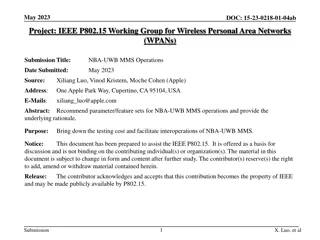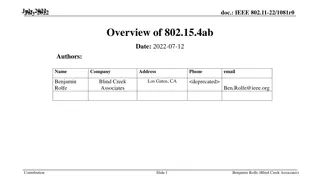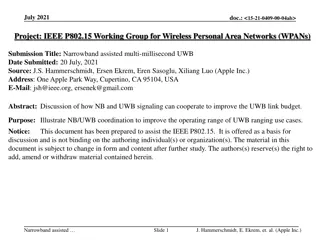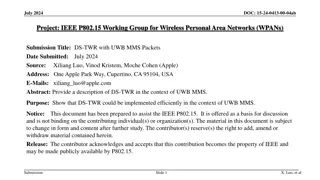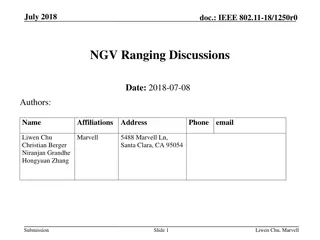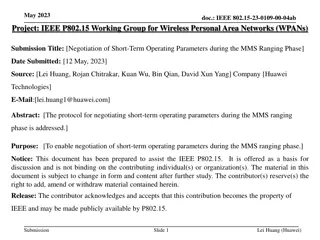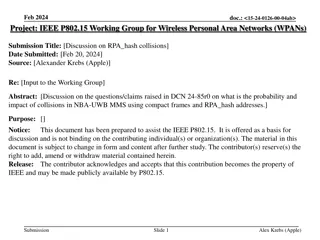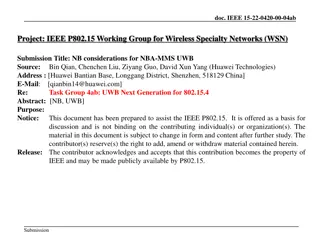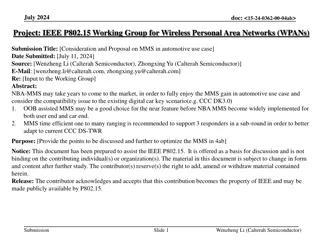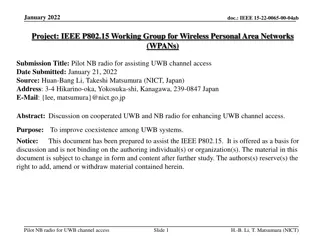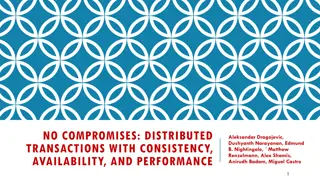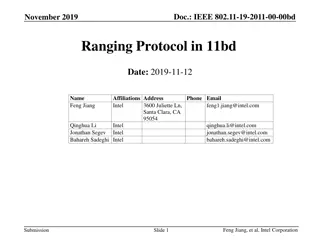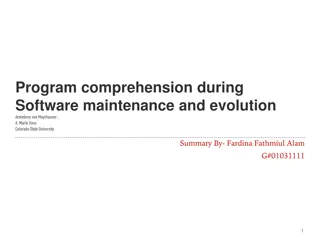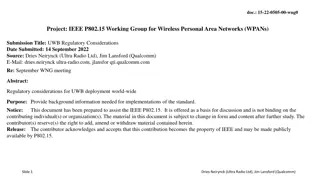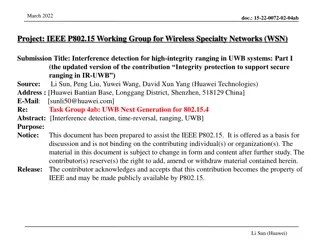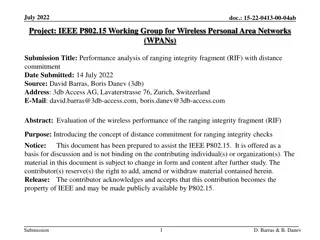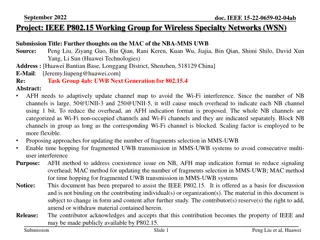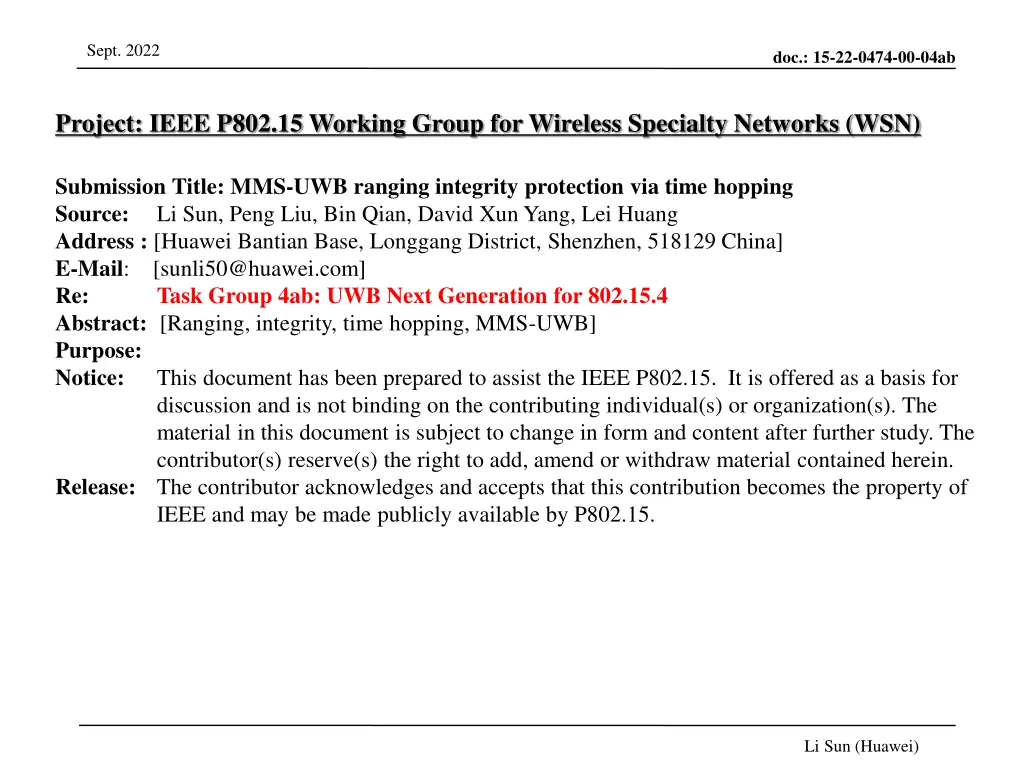
MMS-UWB Ranging Integrity Protection via Time Hopping Submission
Explore the latest submission discussing integrity protection in MMS-UWB ranging through time hopping, aiming to enhance security and accuracy. Learn about proposed solutions, related contributions, and background motivations in the wireless specialty networks domain.
Download Presentation

Please find below an Image/Link to download the presentation.
The content on the website is provided AS IS for your information and personal use only. It may not be sold, licensed, or shared on other websites without obtaining consent from the author. If you encounter any issues during the download, it is possible that the publisher has removed the file from their server.
You are allowed to download the files provided on this website for personal or commercial use, subject to the condition that they are used lawfully. All files are the property of their respective owners.
The content on the website is provided AS IS for your information and personal use only. It may not be sold, licensed, or shared on other websites without obtaining consent from the author.
E N D
Presentation Transcript
Sept. 2022 doc.: 15-22-0474-00-04ab Project: IEEE P802.15 Working Group for Wireless Specialty Networks (WSN) Submission Title: MMS-UWB ranging integrity protection via time hopping Source: Li Sun, Peng Liu, Bin Qian, David Xun Yang, Lei Huang Address : [Huawei Bantian Base, Longgang District, Shenzhen, 518129 China] E-Mail: [sunli50@huawei.com] Re: Task Group 4ab: UWB Next Generation for 802.15.4 Abstract: [Ranging, integrity, time hopping, MMS-UWB] Purpose: Notice: This document has been prepared to assist the IEEE P802.15. It is offered as a basis for discussion and is not binding on the contributing individual(s) or organization(s). The material in this document is subject to change in form and content after further study. The contributor(s) reserve(s) the right to add, amend or withdraw material contained herein. Release: The contributor acknowledges and accepts that this contribution becomes the property of IEEE and may be made publicly available by P802.15. Li Sun (Huawei)
Sept. 2022 doc.: 15-22-0474-00-04ab PAR Objective Proposed Solution (how addressed) Safeguards so that the high throughput data use cases will not cause significant disruption to low duty-cycle ranging use cases Interference mitigation techniques to support higher density and higher traffic use cases Other coexistence improvement Backward compatibility with enhanced ranging capable devices (ERDEVs) Improved link budget and/or reduced air-time Additional channels and operating frequencies Improvements to accuracy / precision / reliability and interoperability for high-integrity ranging Reduced complexity and power consumption The proposed solution can be used to provide an integrity protection for MMS-UWB ranging, thus improving ranging performance. Hybrid operation with narrowband signaling to assist UWB Enhanced native discovery and connection setup mechanisms Sensing capabilities to support presence detection and environment mapping Low-power low-latency streaming Higher data-rate streaming allowing at least 50 Mbit/s of throughput Support for peer-to-peer, peer-to-multi-peer, and station-to- infrastructure protocols Infrastructure synchronization mechanisms Li Sun (Huawei) Slide 2
Sept. 2022 doc.: 15-22-0474-00-04ab Related Contributions Integrity protection to support secure ranging in IR-UWB <15-22- 0072-00-04ab>, Jan. 2022, Li Sun, et. al. Narrowband assisted multi-millisecond UWB <15-21-0409-00-04ab>, Jul. 2021, J. S. Hammerschmidt, et. al. More on mixed MMS for ranging integrity <15-22-0392-00-04ab>, Jul. 2022, Xiliang Luo, et. al. Performance analysis of ranging integrity fragment (RIF) with distance commitment <15-22-0413-00-04ab>, Jul. 2022, David Barras, et al. Time hopping for fragmented UWB transmission in MMS-UWB systems <15-22-0289-00-04ab>, Ziyang Guo, et. al. Li Sun (Huawei) Slide 3
Sept. 2022 doc.: 15-22-0474-00-04ab Background and Motivations (1) Integrity protection, which can be used to detect whether or not the ToA measurement is manipulated, is desired to improve ranging security and accuracy In [1], the concept of ranging integrity protection was proposed, and a time-reversal based high-integrity ranging protocol was developed [1] Integrity protection to support secure ranging in IR-UWB <15-22-0072-00-04ab>, Jan. 2022, Li Sun, et. al. Li Sun (Huawei) Slide 4
Sept. 2022 doc.: 15-22-0474-00-04ab Background and Motivations (2) Multiple-millisecond UWB (MMS-UWB) is a promising technique to improve link budget and ToF measurement accuracy. In [2], a mixed multi-millisecond packet format was proposed to provide ranging integrity, where ranging integrity fragments (e.g., STS) follow preamble fragments for integrity validation. Despite the effectiveness of the aforementioned method, ranging integrity fragments have to be included, which incurs additional transmit power [2] More on mixed MMS for ranging integrity <15-22-0392-00-04ab>, Jul. 2022, Xiliang Luo, et. al. Li Sun (Huawei) Slide 5
Sept. 2022 doc.: 15-22-0474-00-04ab Proposed Method (1) Basic idea: Time hopping, which was proposed in [3] to avoid non- coordinated multi-user interference, can be in combined use with the MMS-UWB ranging to provide ranging integrity. Expand the 1ms spacing to (1+X) ms Divide X ms into M slots, and the preamble fragment hops within M slots LFSR or AES based approach is adopted to generate a pseudo-random sequence, which is used to determine the occupied slot index within each X ms (these slot indices are termed as hopping pattern hereafter) The hopping pattern is only available at the legitimate ranging pairs [3] Time hopping for fragmented UWB transmission in MMS-UWB systems <15-22-0289-00-04ab>, Ziyang Guo, et. al. Li Sun (Huawei) Slide 6
Sept. 2022 doc.: 15-22-0474-00-04ab Proposed Method (2) 1ms 1ms Xms Xms Frag N Frag 2 Frag 3 Frag 1 Poll 1 3 N 2 Slot 3 Slot 1 Slot M Slot 2 Res Time and Freq Sync Ranging measurement and integrity verification: Estimate global ToA by exploiting the entire set of preamble fragments (correlation- based approach and back-search algorithm can be adopted) Infer the start time of each fragment (i.e., per-fragment ToAs) based on the global ToA and the known time hopping pattern Given the per-fragment ToAs obtained above, the receiver extracts all received fragments, and correlates them with the local template (preamble) one by one. The ranging integrity verification passes only if the sum of all correlator s outputs is above a predetermined threshold Li Sun (Huawei) Slide 7
Sept. 2022 doc.: 15-22-0474-00-04ab Enhanced Version (1) In the basic version presented above, the probability of guessing the time-hopping pattern correctly by the attacker is: ?? Assume X=1ms, fragment duration=64us, then the maximum value for M is 15; N is typically equal to or smaller than 8 according to [2] Security level not high enough ??= 158 231 M=15, N=8 Enhanced version 1: Use overlapped time hopping instead of orthogonal time hopping. Xms Xms Slot 2 Slot 3 Slot M Slot 1 M 3 1 2 d There is no slot. Two possible starting positions of the fragment are apart by d ns The fragment can be located within any slot between 1 and M ? ? ? ? The probability of guessing the time-hopping pattern correctly: ? ? e.g., X=1ms, d=32ns, N=8, then =312508 2119 Li Sun (Huawei) Slide 8
Sept. 2022 doc.: 15-22-0474-00-04ab Enhanced Version (2) Enhanced version 2: Security level can be further improved by using D- decimation preamble fragments to replace standard preamble fragments D-decimation sequence [4]: A sequence can be circularly sampled with sampling interval D to produce a new sequence, which is called the D-decimation version of the original sequence Assume a sequence with length L is an lpatov sequence or an m-sequence. Then, as long as D and L are mutually prime, the D-decimation sequence has the same auto-correlation property as the original sequence The aforementioned property implies that all the obtained D-decimation sequences can also be used as the preamble fragment, without sacrificing ranging performance For example, assume L=127, then D can be any integer between 2 and 126. So, the Ipatov preamble fragment with length 127 has 126 different D-decimation versions (including itself) The probability of guessing the time-hopping pattern correctly: (? 1)?? 286 ? ? (M=15, N=8, L=127) Orthogonal time hopping + D-decimation preamble: ? 2175 Overlapped time hopping + D-decimation preamble: (X=1ms, d=32ns, N=8, L=127) ? 1 [4] A. Canteaut, et. Al., Binary m-sequences with three-valued crosscorrelation: A proof of Welch s conjecture, IEEE TIT, 2000. Li Sun (Huawei) Slide 9
Sept. 2022 doc.: 15-22-0474-00-04ab Summary A time-hopping based method is proposed to enable high-integrity ranging for MMS-UWB. Integrity validation scheme is also developed, which enjoys a low implementation complexity. Compared with the mixed MMS method, the proposed approach transmits fewer pulses within a given ranging round. This does not only save transmit power but also decreases interference to other devices. Time-hopping is a useful tool for MMS-UWB, which brings benefits to both interference mitigation and ranging integrity protection. Li Sun (Huawei) Slide 10

